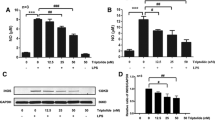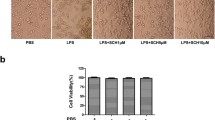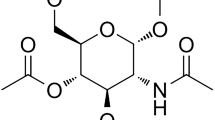Abstract
Objective
Based on recent information, CD200Fc, a CD200R1 agonist, could attenuate the inflammatory response of microglial cells in autoimmune diseases and neuro-degeneration. However, the exact molecular mechanisms responsible for the anti-inflammatory activity of CD200Fc in microglial cells have not been elucidated. In the present study, we investigated the anti-inflammatory effects and the molecular mechanisms of CD200Fc in lipopolysaccharide (LPS)-stimulated rat primary microglial cells.
Methods
The cell viability was measured by MTT assay. The LPS-induced cytokines release (IL-1β, IL-6, TNF-α, iNOS, MCP-1, and COX-2) was monitored by ELISA or real-time PCR, while NF-κB-related signals (MyD88, p-TAK1, TRIF, p-TBK1, p-IRF3, p-IκB, and NF-κB-P65) were assessed by real-time PCR, western blot and/or Immunofluorescent staining.
Results
CD200Fc and/or LPS exerted no significant cytotoxicity on microglial cells. LPS reduced the CD200R1 expression in microglial cells, and this effect was attenuated by CD200Fc. In addition, CD200Fc inhibited LPS-induced expression of TLR4 and its adapter molecules (MyD88 and p-TAK1, TRIF, p-TBK1, and p-IRF3), and abolished its interactions with MyD88, TAK1, and TRIF in microglial cells. CD200Fc also attenuated LPS-induced protein expression of p-IκB and NF-κB-P65 translocation to nucleus in microglial cells. Moreover, CD200Fc suppressed the LPS-induced release of inflammatory mediators in microglial cells, including IL-1β, IL-6, TNF-α, iNOS, MCP-1, and COX-2.
Conclusion
These results indicated that CD200Fc displayed an anti-inflammatory effect in LPS-induced microglial cells by blocking TLR4-mediated NF-κB activation.







Similar content being viewed by others
References
Ahmad S, Elsherbiny NM, Bhatia K, Elsherbini AM, Fulzele S, Liou GI. Inhibition of adenosine kinase attenuates inflammation and neurotoxicity in traumatic optic neuropathy. J Neuroimmunol. 2014;277:96–104.
Maneu V, Noailles A, Megias J, Gomez-Vicente V, Carpena N, Gil ML, et al. Retinal microglia are activated by systemic fungal infection. Invest Ophthalmol Vis Sci. 2014;55:3578–85.
Rana T, Shinde VM, Starr CR, Kruglov AA, Boitet ER, Kotla P, et al. An activated unfolded protein response promotes retinal degeneration and triggers an inflammatory response in the mouse retina. Cell Death Dis. 2014;5:e1578.
Sierra A, Navascues J, Cuadros MA, Calvente R, Martin-Oliva D, Ferrer-Martin RM, et al. Expression of inducible nitric oxide synthase (iNOS) in microglia of the developing quail retina. PLoS One. 2014;9:e106048.
Zhao J, Ha Y, Liou GI, Gonsalvez GB, Smith SB, Bollinger KE. Sigma receptor ligand, (+)-pentazocine, suppresses inflammatory responses of retinal microglia. Invest Ophthalmol Vis Sci. 2014;55:3375–84.
Aslanidis A, Karlstetter M, Scholz R, Fauser S, Neumann H, Fried C, et al. Activated microglia/macrophage whey acidic protein (AMWAP) inhibits NFkappaB signaling and induces a neuroprotective phenotype in microglia. J neuroinflamm. 2015;12:77.
Yu Z, Tang L, Chen L, Li J, Wu W, Hu C. Capillarisin suppresses lipopolysaccharide-induced inflammatory mediators in BV2 microglial cells by suppressing TLR4-mediated NF-kappaB and MAPKs signaling pathway. Neurochem Res. 2015;40:1095–101.
Dai XJ, Li N, Yu L, Chen ZY, Hua R, Qin X, et al. Activation of BV2 microglia by lipopolysaccharide triggers an inflammatory reaction in PC12 cell apoptosis through a toll-like receptor 4-dependent pathway. Cell stress chaperones. 2015;20:321–31.
Hernangomez M, Mestre L, Correa FG, Loria F, Mecha M, Inigo PM, et al. CD200-CD200R1 interaction contributes to neuroprotective effects of anandamide on experimentally induced inflammation. Glia. 2012;60:1437–50.
Masocha W. Systemic lipopolysaccharide (LPS)-induced microglial activation results in different temporal reduction of CD200 and CD200 receptor gene expression in the brain. J Neuroimmunol. 2009;214:78–82.
Costello DA, Lyons A, Denieffe S, Browne TC, Cox FF, Lynch MA. Long term potentiation is impaired in membrane glycoprotein CD200-deficient mice: a role for Toll-like receptor activation. J Biol Chem. 2011;286:34722–32.
Cox FF, Carney D, Miller AM, Lynch MA. CD200 fusion protein decreases microglial activation in the hippocampus of aged rats. Brain Behav Immun. 2012;26:789–96.
Ding Y, Yang H, Xiang W, He X, Liao W, Yi Z. CD200R1 agonist attenuates LPS-induced inflammatory response in human renal proximal tubular epithelial cells by regulating TLR4-MyD88-TAK1-mediated NF-kappaB and MAPK pathway. Biochem Biophys Res Commun. 2015;460:287–94.
Roque RS, Caldwell RB. Isolation and culture of retinal microglia. Curr Eye Res. 1993;12:285–90.
Dong N, Li X, Xiao L, Yu W, Wang B, Chu L. Upregulation of retinal neuronal MCP-1 in the rodent model of diabetic retinopathy and its function in vitro. Invest Ophthalmol Vis Sci. 2012;53:7567–75.
Fitzgerald KA, Palsson-McDermott EM, Bowie AG, Jefferies CA, Mansell AS, Brady G, et al. Mal (MyD88-adapter-like) is required for Toll-like receptor-4 signal transduction. Nature. 2001;413:78–83.
Ren X, Lv F, Fang B, Liu S, Lv H, He G, et al. Anesthetic agent propofol inhibits myeloid differentiation factor 88-dependent and independent signaling and mitigates lipopolysaccharide-mediated reactive oxygen species production in human neutrophils in vitro. Eur J Pharmacol. 2014;744:164–72.
Hayden MS, Ghosh S. Shared principles in NF-kappaB signaling. Cell. 2008;132:344–62.
Xiang HF, Cao DH, Yang YQ, Wang HQ, Zhu LJ, Ruan BH, et al. Isoflurane protects against injury caused by deprivation of oxygen and glucose in microglia through regulation of the Toll-like receptor 4 pathway. J Mol Neurosci. 2014;54:664–70.
Walker DG, Dalsing-Hernandez JE, Campbell NA, Lue LF. Decreased expression of CD200 and CD200 receptor in Alzheimer’s disease: a potential mechanism leading to chronic inflammation. Exp Neurol. 2009;215:5–19.
Koning N, Bo L, Hoek RM, Huitinga I. Downregulation of macrophage inhibitory molecules in multiple sclerosis lesions. Annals Neurol. 2007;62:504–14.
Koning N, Swaab DF, Hoek RM, Huitinga I. Distribution of the immune inhibitory molecules CD200 and CD200R in the normal central nervous system and multiple sclerosis lesions suggests neuron-glia and glia-glia interactions. J Neuropathol Exp Neurol. 2009;68:159–67.
Frank MG, Barrientos RM, Biedenkapp JC, Rudy JW, Watkins LR, Maier SF. mRNA up-regulation of MHC II and pivotal pro-inflammatory genes in normal brain aging. Neurobiol Aging. 2006;27:717–22.
Taylor S, Calder CJ, Albon J, Erichsen JT, Boulton ME, Morgan JE. Involvement of the CD200 receptor complex in microglia activation in experimental glaucoma. Exp Eye Res. 2011;92:338–43.
Copland DA, Calder CJ, Raveney BJ, Nicholson LB, Phillips J, Cherwinski H, et al. Monoclonal antibody-mediated CD200 receptor signaling suppresses macrophage activation and tissue damage in experimental autoimmune uveoretinitis. Am J Pathol. 2007;171:580–8.
Broderick C, Hoek RM, Forrester JV, Liversidge J, Sedgwick JD, Dick AD. Constitutive retinal CD200 expression regulates resident microglia and activation state of inflammatory cells during experimental autoimmune uveoretinitis. Am J Pathol. 2002;161:1669–77.
Guo K, Mou X, Huang J, Xiong N, Li H. Trans-caryophyllene suppresses hypoxia-induced neuroinflammatory responses by inhibiting NF-kappaB activation in microglia. J Mol Neurosci. 2014;54:41–8.
Gong G, Bai S, Wu W, Hu L, Liu Y, Niu J, et al. Lrg participates in lipopolysaccharide preconditioning-induced brain ischemia injury via TLR4 signaling pathway. J Mol Neurosci. 2014;54:20–6.
Plociennikowska A, Hromada-Judycka A, Borzecka K, Kwiatkowska K. Co-operation of TLR4 and raft proteins in LPS-induced pro-inflammatory signaling. Cell Mol Life Sci. 2015;72:557–81.
Bryant CE, Symmons M, Gay NJ. Toll-like receptor signalling through macromolecular protein complexes. Mol Immunol. 2015;63:162–5.
Acknowledgments
This study was supported by the National Natural Science Foundation of China (No. 81460087 and No. 81560166), the Natural Science Foundation of Guangxi Zhuang Autonomous Region (No. 2012GXNSFAA276039 and No. 2011GXNSFA018228), and the Science Fund Project of People’s Hospital of Guangxi Zhuang Autonomous Region (No. qn2014-1 and qn2014-2).
Author information
Authors and Affiliations
Corresponding authors
Ethics declarations
Conflict of interest
All authors declare that they have no conflict of interest.
Additional information
Responsible Editor: John Di Battista.
L. Jiang, F. Xu, and W. He contributed equally to this work.
Rights and permissions
About this article
Cite this article
Jiang, L., Xu, F., He, W. et al. CD200Fc reduces TLR4-mediated inflammatory responses in LPS-induced rat primary microglial cells via inhibition of the NF-κB pathway. Inflamm. Res. 65, 521–532 (2016). https://doi.org/10.1007/s00011-016-0932-3
Received:
Revised:
Accepted:
Published:
Issue Date:
DOI: https://doi.org/10.1007/s00011-016-0932-3




